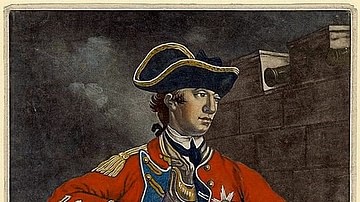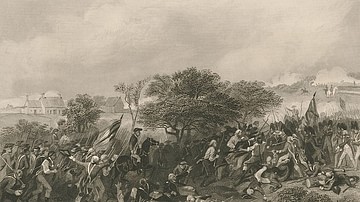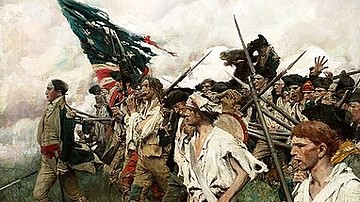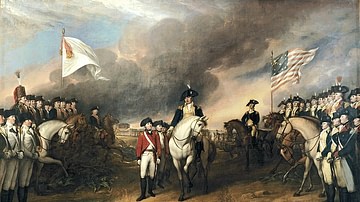The Battle of Germantown (4 October 1777) was a major battle of the American Revolutionary War (1775-1783) in which General George Washington launched an unsuccessful assault on the British army garrisoned in Germantown, Pennsylvania. After the failure of his attack, Washington withdrew his army into winter quarters at Valley Forge to retrain and reorganize his forces.
The battle was part of the Philadelphia Campaign (July 1777 to June 1778), launched by British General Sir William Howe to capture the United States capital of Philadelphia. After defeating the Continental Army at the Battle of Brandywine (11 September 1777), Howe entered Philadelphia uncontested on 26 September. Washington, hoping to defeat Howe and retake the capital, decided to launch a surprise attack on the main body of 9,000 British troops garrisoned at Germantown, near Philadelphia. The attack began in a thick fog on the morning of 4 October, the Americans utilizing the element of surprise to chase off the British pickets. However, coordination between the various American units quickly broke down in the fog, causing the assault to lose momentum. Chaos and disorder soon took over, leading to friendly fire between American units, and the Continental Army broke and fled once the British counterattacked.
The attack at Germantown failed partly because of the confusion caused by the thick fog, but also because the soldiers were not yet disciplined enough to carry out the complex maneuvers that Washington's plan had required of them. Recognizing this, Washington spent the following winter at Valley Forge reorganizing and retraining his soldiers, turning them into a more disciplined and effective army.
Background
On 25 August 1777, a British army led by Sir William Howe disembarked at Head of Elk, Maryland. Its target was the United States capital of Philadelphia, the capture of which would hopefully bring about an end to the American rebellion. As Howe began his drive toward Philadelphia, General George Washington and the Continental Army were lying in wait for him at Brandywine Creek in the modern township of Chadds Ford, Pennsylvania. While Washington had positioned his troops at most of the major crossings over the Brandywine, he had neglected to sufficiently strengthen his right flank, which remained dangerously exposed. Loyalist scouts took the news of the vulnerable American flank to Howe, who planned a flanking maneuver; on 11 September 1777, the British launched an artillery bombardment on the American center to keep them distracted, while 9,000 British troops marched around the American line to strike their exposed flank. Although the Continentals were caught off guard, they held their ground long enough for the rest of the army to embark on a coordinated retreat to the town of Chester, some 14 miles (22 km) away. The Battle of Brandywine, therefore, resulted in an American defeat; but, although Washington had lost around one-tenth of his men, he had kept the Continental Army intact, thereby depriving Howe of the decisive victory he so desperately needed.
Over the course of the next several days, the British and Continental armies faced off, engaged in an awkward dance of maneuvers as Washington tried to prevent Howe from reaching Philadelphia. On 16 September, it seemed as though a major battle might be fought at Warren Tavern, between Lancaster and Philadelphia; but as the two sides formed up for battle, a torrential storm broke out, soaking the cartridges and gunpowder of both armies (this aborted fight was later termed the Battle of the Clouds). The storm continued well into the next day, allowing Washington to pull back; Howe showed no particular eagerness to pursue him as this would require marching over muddy, churned-up roads. Washington, therefore, retreated beyond the Schuylkill River on 19 September, leaving behind a division of 1,500 men under General Anthony Wayne to harry the British rear.
General Wayne, encamped at Paoli Tavern only 2 miles (3 km) from the British camp, assumed that he was undetected by the enemy, especially once the main British force began slowly moving toward the Schuylkill in pursuit of Washington, but he was gravely mistaken. At 10 p.m. on 20 September 1777, a detachment of 1,200 British soldiers under Major General Charles Grey silently approached Wayne's encampment. To maintain the element of surprise, Grey had ordered his men to remove the flints from their muskets and only use the bayonet, which would subsequently earn him the nickname 'No Flint' Grey. As the American soldiers were settling into their cots for the night, Grey's troops swept into the camp, bayoneting the sentries, and rushing from tent to tent to let their bayonets do their grisly work. Wayne's men, though still groggy with sleep, managed to form up and fire at the British intruders, but the onslaught of Grey's men proved too much, and Wayne ordered a retreat into the dark woods. As many as 200 Americans were killed or wounded in the night attack, with another hundred taken prisoner; the British had lost only four killed and seven wounded.
The Battle of Paoli (or the Paoli Massacre as the Americans called it) disturbed Washington, who had been carefully maneuvering to avoid such unnecessary contact with the enemy. Howe noticed Washington's sudden timidity and decided to take advantage of his opponent's fear of being outflanked. On 22 September, the British feinted north, giving the impression that they meant to fall upon the American flank. Washington took the bait, marching 10 miles (16 km) north to better position himself, at which point the British swiveled back in the opposite direction, toward the now undefended Philadelphia. On 26 September 1777, Lord Charles Cornwallis led the vanguard of the British army into the United States capital, which had recently been evacuated by the Continental Congress.
Preparations
Although he now held the two most important cities in the Thirteen Colonies (New York City and Philadelphia), Howe did not feel that his position was secure. For one thing, the Patriots still controlled access to the Delaware River, which was guarded by Fort Mifflin and Fort Mercer; they could prevent vital supplies and reinforcements from reaching Howe in Philadelphia. Additionally, Washington's Continental Army was resting only 25 miles (40 km) away at Skippack Creek, much too close for Howe's comfort. The combination of Washington's army, prowling somewhere just out of sight, and the Patriot forts standing firm along the Delaware made Howe feel isolated, deep within enemy territory. He feared keeping his army clumped together in Philadelphia, where it might become trapped if the city were to come under siege, and therefore moved 9,000 men to Germantown, 5 miles (8 km) to the north on the east side of the Schuylkill River. A further 3,000 men were sent to Elktown to guard the transportation of British supplies, leaving less than 3,000 men to garrison Philadelphia itself.
When Washington learned that Howe had spread his forces so thinly, he was delighted. If he could only surprise and defeat the largest chunk of the British army at Germantown, he could feasibly force Howe to surrender; combined with the recent American successes in the concurrent Saratoga Campaign (20 June to 19 October 1777), a victory at Germantown might very well mean an end to the war itself. Washington, who had pulled off a similar surprise attack at the Battle of Trenton (26 December 1776), had no doubt that he could do it again. He issued a general order in which he appealed to the pride of his men and also fostered a bit of competition with the northern American army, which had been performing so well at Saratoga:
This army, the main American army, will certainly not suffer itself to be outdone by their northern brethren; they will never endure such disgrace; but with an ambition becoming freemen, contending in the most righteous cause rival the heroic spirit which swelled in their bosoms, and which, so nobly exerted had procured them deathless renown. Covet! my countrymen, my fellow soldiers! Covet! a share of the glory due to heroic deeds! Let it never be said that in a day of action, you turned your backs on the foe; let the enemy no longer triumph! (Middlekauff, 397)
Having inspired his men, Washington was ready to set out. To prevent Howe from ascertaining his intentions, Washington waited for nightfall on 3 October 1777 before striking camp. Then, he covered the 20 miles (32 km) to Germantown in a forced march before coming to a halt at 2 a.m., barely 2 miles (3 km) away from the British pickets. The plan was to launch a multipronged assault: Major General John Sullivan's brigade would lead the main attack down Skippack Road (Germantown's primary road) supported by Wayne's brigade. General Nathanael Greene would lead a simultaneous attack on the British flank, while the militia under General William Smallwood would get behind the British and cut off their retreat. With this maneuver, Washington hoped to trap the British garrison in Germantown and force their surrender. He let his men rest as he waited for the first light of dawn, looking forward to the battle that would win the war – or so he hoped.
The Battle
At 5 a.m. on 4 October 1777, the Americans struck; the sun had just risen, but a thick blanket of fog made it rather difficult to tell. The vanguard of General John Sullivan's division moved up Skippack Road and, disregarding Washington's orders to only use the bayonet, fired on the British pickets at Mount Airy. Several British sentries crumpled to the ground, as their startled comrades tried to return fire, but the fog obscured visibility, leading the British to do little but fire blindly in the direction they believed the enemy was coming from. The sound of musket fire alerted General Howe, who rode up to Mount Airy to see what the matter was. He found his pickets on the brink of retreat, which irked the general; having no reason to believe that Washington had left Skippack Creek, he figured that they were being faced with an American foraging party or, at worst, some headstrong Patriot militiamen. "Form! Form!" Howe cried, angrily berating his men for yielding to a scouting party (Middlekauff, 400).
It was then that the air was filled with the thunderous roar of American artillery, as pieces of grapeshot shredded into the British troops. Out of the thick fog came Sullivan's infantry, bayonets fixed, causing the terrified British soldiers to flee; Howe and his staff raced back to Germantown, to alert the rest of the garrison. As the British fled, a party of around 120 soldiers from the 40th Regiment of Foot became disorientated and were soon cut off from the main force. Hearing the rapid approach of the American troops, they decided to enter and barricade an old stone house called Cliveden, belonging to Pennsylvania Justice Benjamin Chew (who was not home). Sullivan's troops assaulted Cliveden but were driven back with heavy losses; the mansion's stone walls proved too much for them to penetrate. Frustrated, Sullivan's men kept up the assault on Cliveden for the next hour, wasting precious time, ammunition, and lives attacking a house that they could have simply bypassed.
Washington realized time was of the essence but decided he could not leave a building full of British troops behind his lines. He ordered Sullivan to continue his assault, bringing up General William Maxwell's brigade from the reserves to continue the assault on Cliveden. Maxwell, working with Brigadier General Henry Knox, brought up several pieces of artillery and bombarded the house, but the stone walls of Cliveden held, and the bombardment came to no avail. Next, Maxwell ordered another assault on the building; this attack was led by Colonel John Laurens, an officer from Washington's staff. Laurens' attack was bloodily repulsed, and the few American troops who made it inside Cliveden were bayoneted to death.
As the British troops at Cliveden continued to frustrate the Americans, General Sullivan continued his advance. The fog had not let up, and Sullivan's men quickly became disorientated as they lumbered on toward Germantown; what was worse, they had expended almost all their ammunition in the initial attacks on Mount Airy and in their hour-long assault on Cliveden. By the time Sullivan made it to Germantown, Howe had had enough time to form up his own troops, and the two sides began to exchange fire. It was at this time that General Greene appeared on the battlefield, 45 minutes behind schedule; he, too, had become disorientated in the fog and had not been able to get into his starting position in time. Greene, hoping to plug the gap between his and Sullivan's forces, sent General Adam Stephen's division to take up a position on his right flank. As Stephen's men approached this position, marching blindly through the fog with bullets buzzing around them, they noticed a group of men quickly coming toward them from the opposite direction. Assuming they were redcoats, Stephen's already jittery troops opened fire.
As it happened, the men that Stephen's division fired on were not redcoats, but General Wayne's brigade; Wayne, who had initially been sent in support of Sullivan, had gotten lost and had been wandering around in the fog. Startled, Wayne's troops returned fire and both units broke and fled from the field, neither one realizing that they had committed friendly fire. As luck would have it, General Howe chose this moment to launch a counterattack and hurled three regiments against the American line. The British troops streamed through the gap where Stephen and Wayne were supposed to be and thereby enveloped the American position. Sullivan's troops turned and fled within minutes of the counterattack. Greene's men fared a little better; the 9th Virginia Regiment managed to break through the British line and take 100 prisoners. However, the Virginians soon found themselves surrounded and were forced to surrender themselves. When Greene realized that Sullivan had already retreated, he decided to cut his losses and withdrew as well. For General Smallwood, leading the American militia, the fight was over before he was even in position.
While all this was unfolding, the American siege of Cliveden continued. His previous two assaults having failed, Colonel Laurens came up with an idea; he ordered his men to start piling firewood in front of the house in order to smoke the British out. However, the flame did not catch, and to add insult to injury, Laurens was wounded in the shoulder while trying to light it. As General Maxwell pondered what to do next, word reached him that the main assault had failed, causing Maxwell to order a retreat as well. The Americans, who had come to Germantown with grandiose hopes of winning the war in a single stroke, in the end, proved incapable of seizing even a single stone house.
Aftermath
The Americans utilized the fog, and the eventual onset of darkness, to cover their retreat. By the end of the day, they had pulled back to Pennybacker's Mill, about 12 miles (19 km) to the west. It had been a humiliating defeat for the Continentals, who had lost roughly 152 killed, 520 wounded, and another 400 captured, compared to 71 killed and 448 wounded for the British. It must have been a frustrating experience for Washington, considering how well the battle had been going at first. The plan, which called for a multipronged assault, relied on close cooperation between Sullivan, Greene, and Smallwood's troops, cooperation that was made impossible by the fog. Furthermore, it became apparent that the Continentals were not yet disciplined enough to carry out the complex maneuvers that Washington had asked of them or to stand their ground during chaotic fights; it was clear that they would have to be retrained.
Howe, meanwhile, did not follow up on his victory and pursue Washington's army. Instead, he sent troops to seize forts Mifflin and Mercer in order to open up the Delaware River to British supplies. This was accomplished by mid-November, but, instead of pursuing Washington then, Howe entered winter quarters. He continued to feel isolated in Philadelphia and soon became bitter, believing that his superiors in London had not adequately supported him during the campaign. In late October, Howe wrote to London offering his resignation; this was accepted, and he was replaced in April 1778 by Sir Henry Clinton, a man he detested.
As the British sat in Philadelphia, Washington moved his own army into winter quarters at Valley Forge, where they would spend the brutal winter of 1777-78. Many Continental soldiers died from smallpox or the elements at Valley Forge, but Washington was able to retrain and reorganize the army with the help of foreign officers like the Prussian Baron Friedrich Wilhelm von Steuben. In February 1778, the United States officially entered into an alliance with France, which guaranteed that French troops and ships would soon enter into the war. The British realized they needed to consolidate their forces in the face of a potential French attack, and so General Clinton was ordered to abandon Philadelphia and return to New York City. On his march back to Manhattan, Clinton was attacked by Washington at the Battle of Monmouth Court House (28 June 1778), the last battle of the Philadelphia Campaign. The battle was inconclusive, and Clinton marched to New York City, with Washington taking up position in White Plains, New York. Therefore, although the American defeat at Germantown had been disheartening, its consequences were not long-lasting; by the end of 1778, the two armies were in much the same position that they had been in at the end of 1776, before the Philadelphia Campaign.












